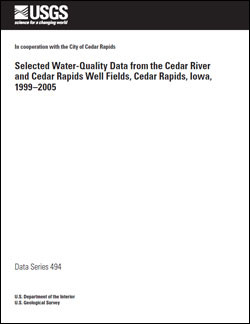
Product Details
- Product Number
- 527402
- Series
- SIR-2018-5090
- Scale
- NO SCALE
- Alternate ID
- SIR-2018-5090
- Authors
- CITY OF CEDAR RAPIDS, IOWA
- Version Date
- 01/01/2018
- Countries
- USA
- Media
- Paper
- Format
- Bound
Additional Details
- Description
-
Abstract
First posted August 2, 2018
For additional information, contact:
Director, Central Midwest Water Science Center U.S. Geological Survey 400 South Clinton Street Room 269 Iowa City, Iowa 52240-4105
Nitrate concentrations in the Cedar River in Iowa and Minnesota have increased from an average of less than 1.0 milligram per liter in the early 1900s to more than 5.0 milligrams per liter in the 2000s and have resulted in periodic water-quality impairment of the river. Spatial differences and temporal changes in nitrogen and phosphorus transport in the Cedar River Basin are described for the period from 2000 to 2015. Data used to estimate nitrogen and phosphorus transport were collected by the U.S. Geological Survey as part of six base-flow synoptic studies and by the Minnesota Pollution Control Agency and the Iowa Department of Natural Resources as part of their long-term stream and river monitoring programs. The Cedar River transported an annual average of 53,100 tons of total nitrogen and 2,510 tons of total phosphorus during 2000–15. Three subbasins yielded an annual average of more than 30 pounds per acre (lb/acre) of nitrogen to the Cedar River, whereas two subbasins yielded an annual average of less than 20 lb/acre of nitrogen. The average annual total phosphorus yield from the Little Cedar River subbasin (0.35 lb/acre) was only about 16 percent of the yield from the greatest total phosphorus yielding Lower Cedar River subbasin (more than 1.0 lb/acre). The annual total nitrogen and total phosphorus loads did not change significantly during the study. The relation between annual stream runoff and annual total nitrogen and total phosphorus yields was not spatially uniform across the Cedar River Basin. The Beaver Creek, Black Hawk Creek, and Wolf Creek subbasins yielded the most, and the Main Stem Middle Cedar River, the Lower Cedar River, and the Little Cedar River subbasins yielded the least amount of nitrogen for a given amount of runoff. The Lower Cedar River and Wolf Creek subbasins yielded the most and the West Fork Cedar River and the Little Cedar River subbasins yielded the least phosphorus for a given amount of runoff. The results of this study describe nutrient transport during 2000–15 that can be used to evaluate future progress of nutrient reduction strategies in the Cedar River Basin.
- Print Date
- 2018
- Height In Inches
- 11.000
- Width In Inches
- 0.150
- Length In Inches
- 8.500
- Two Sided
- Yes
- Pieces
- 1
- Languages
- English




